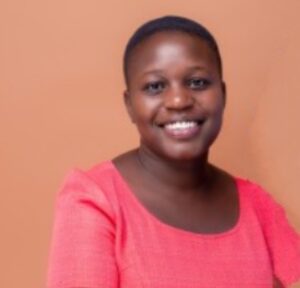 Harriet Adhiambo is a PhD Nursing Science student at the University of Washington with experience in clinical and implementation science research. Her work has mainly focused on improving maternal, child, and adolescent health outcomes using innovative strategies including mHealth and improving retention and viral load suppression among patients living with HIV/AIDs in Western Kenya. She is currently working at the Webel Research Lab as a Graduate Research Student Assistant in the High Intensity Exercise to Attenuate Limitations and Train Habits in Older Adults with HIV study (HEALTH).
Harriet Adhiambo is a PhD Nursing Science student at the University of Washington with experience in clinical and implementation science research. Her work has mainly focused on improving maternal, child, and adolescent health outcomes using innovative strategies including mHealth and improving retention and viral load suppression among patients living with HIV/AIDs in Western Kenya. She is currently working at the Webel Research Lab as a Graduate Research Student Assistant in the High Intensity Exercise to Attenuate Limitations and Train Habits in Older Adults with HIV study (HEALTH).
This interview is a part of a series on ageism, completed by de Tornyay Center predoctoral scholar, Sarah McKiddy (sm256@uw.edu). Read her article on ageism here, and find more interviews on ageism here.
What are two to three action items that we could do on an individual, practical level to redirect ageist remarks by others?
We first need to speak with individuals who feel they are now old and cannot perform certain tasks and do not want to take the time to think through things because they feel or fear they’re too old for them. Some older adults feel like they can’t go out and dance. But who said that? Talking to individuals could help create a different mind shift. Everyone will grow old, but it does not mean being old you’re incapacitated – mentally, emotionally, or physically. Do what you can as a person. If you love dancing, dance. If you love music, listen to music or participate in music. Keep yourself active because idleness and not engaging yourself very much leads to thoughts of no longer being valuable. Talk to them and give them even examples. You could also form groups or clubs for people to meet and engage them in exciting activities and encourage them to do the work if they have the strength.
The fact that someone is incapacitated, or has some illnesses, should not push them down. They should still seek treatment but continue doing what they can. In Kenya, there is an expression we call “old age syndrome”, in which you start complaining of headaches, stomach aches, and all these symptoms. For the family, it is most helpful to be supportive.
I’ve observed in the U.S. that when people get older, they’re taken to adult family homes because they need someone to take care of them. Sometimes, the environment may not be as conducive because they’re going to an environment with people who are not familiar to them. You need a social support system. Those who are still working probably feel they don’t have the time to take care of their parents, so they move them to other community homes. What are the alternatives? Can a caregiver take care of a relative in their home environment?
Ageism is a global challenge, but there are unique variances in the ways that different countries, cultures, and communities discuss aging. How can we make this a collective global effort?
It will involve stakeholder engagement not just within the U.S. – globally. Engage all global leaders in this discussion. For example, In Kenya, if you want to engage in such, we can involve the people at the community level because, in Kenya, most people stay within the communities or the rural places. We need to engage as many community members who are considered older adults — or, as we say in Kenya, simply “old people” — as possible. Ask them what they want to see because if you get their opinion, you’ll be able to better advance in terms of the interventions you want to offer to them. And then these interventions will have a better chance of improving their lives so they can live fulfilling lives. With elders, global leaders, and stakeholders, you need their perspectives on aging and the particulars unique to each community. We need to bring all those ideas together and ask ourselves what our priorities are and what is achievable now – short-term, mid-term, and long-term.